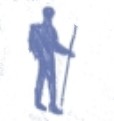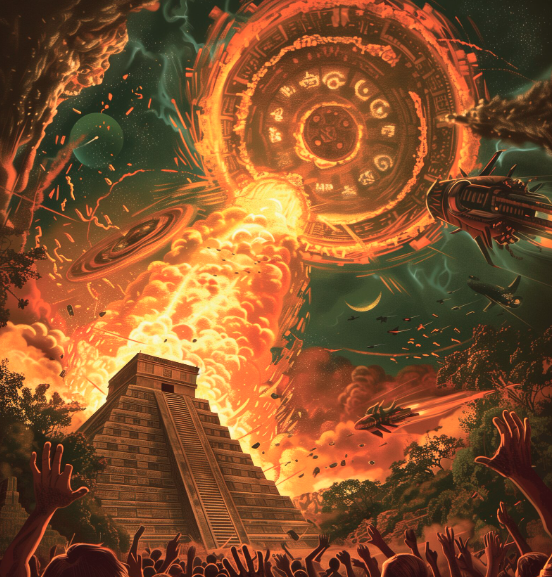Published in Perspective
April 2024
In December 1790, workers in Mexico City discovered a twelve-foot block of basalt covered in concentric glyphs carved around a leering face. The face was likely that of Tonatiuh, an Aztec solar deity, and the glyphs denoted “wind”, “house”, “serpent”, “death”, “deer”, “rabbit”, “monkey”, “reed” and the other day-signs of the Aztec sacred calendar. Also depicted were the “four suns” – previous eras of creation destroyed by respective cataclysms – and the current era, known as the “fifth sun”. Despite its pagan symbolism the Aztec Sun Stone, as it became known, was mounted on the wall of the city’s cathedral until 1885, before being moved to a museum. It has become one of Mexico’s most recognisable icons.
In the late twentieth century, however, it was another calendar from pre-conquest Mesoamerica that became an object of obsession – and even fear – around the world. This was the Long Count of the Maya, whose civilisation predated the Aztecs by thousands of years. Advanced in astrology and mathematics, the Maya developed three calendars that combined agricultural cycles and celestial events: the tzolk’in of 260 days, the haab’ of 365 days, and the Long Count, which was used for much vaster measures of time.
According to the Popul Vuh, the sacred text of the K’iche’ Maya, the fourth era of creation had begun on 11 August 3114 BC, and would last for thirteen ba’k’tuns (periods of 144,000 days), or around 5,125 years. When the thirteenth ba’k’tun ended, the calendar would reset, bringing that era to a close. That date fell on 21 December 2012.
Ancient Mayan dating systems are, to put it mildly, complicated, composed of interlocking cog wheels that revolve to produce combinations of numerals and day-signs. No wonder the study of their secrets was a sacred pastime. Beyond academics with a head for numbers – and of course the Mayan people who still live in Mexico and Central America today – the thirteenth ba’k’tun would have ended with little fanfare. But in the 1960s, the idea of an impending cataclysm found a ready audience in the burgeoning counterculture.
In 1966, the archaeologist Michael D. Coe wrote in his bestselling book The Maya of the suggestion that “Armageddon would overtake the degenerate peoples of the world and all creation” when the portentous date came around. William S. Burroughs and Terence McKenna helped popularise the idea, influenced by their visionary journeys with psychotropic plants. Doubtless stoked by Cold War fears of nuclear apocalypse – and also by New Age beliefs in a coming transformation of consciousness – rumours of this ancient “prophecy” spread around the world.
After the year 2000 – which many people feared would also usher in apocalypse, in the form of the Y2K computer bug – the countdown to the end of the fourth sun began in earnest. The internet fuelled fevered predictions of what the day would bring, including alien visitation, a reversal of the Earth’s magnetic poles, collision with a planet called Nibiru, and a giant solar flare. Mystical thinkers identified sites that might provide spiritual protection, leading to localised booms in a kind of doomsday tourism.
In the south of France, people flocked to a tiny Pyrenean village to ascend the Pic de Bugarach, a mountain that had long been associated with UFO sightings. The Guardian reported that “hippy cults were claimed to have built bunkers beneath the village, and half-naked ramblers were said to be seen wandering up the mountain in procession, ringing bells.” A Serbian mountain called Rtanj, believed by some to be a long-lost pyramid and a node of sacred energy, was also suggested as a location to weather the coming chaos. Nearby hotels did a roaring trade, with one hotel owner reporting that 500 people had attempted to book rooms in a single day. In Turkey, the picturesque village of Şirince, normally known for its wine production, steeled itself for the arrival of 60,000 devotees. Vendors sold doomsday-themed merchandise and even apocalypse-branded wine in anticipation of a bacchanalian blow-out.
Elsewhere, things took a darker turn. In China, a Christian cult predicted the end of Communism, which led to the mass arrest of hundreds of its members. A man in the village of Chenpeng, who admitted to being influenced by the prediction, wounded 23 schoolchildren in a knife attack. A Facebook user in Argentina proposed a mass suicide on the summit of Uritorco – another mountain associated with extraterrestrial happenings – to enable spiritual seekers to pass through an interdimensional portal and create “an army of light that will save humanity”. Americans, in disaster movie style, constructed blast-proof bunkers.
When 21 December came around, it was all rather anticlimactic. Contrary to expectations, tens of thousands of devotees did not descend on Şirince or Rtanj, and opportunistic merchandise vendors were left disappointed. In Bugarac, the police shut down a couple of attempted raves, but crowd numbers were a fraction of what had been predicted. There were no mass suicides, and Chinese Communism did not fall. The internet’s attention moved on and interest fizzled out.
Few people had bothered to ask the Mayans what the date meant to them. On winter solstice 2012, priests and worshippers gathered at Chichén Itzá in Mexico, Tikal in Guatemala, Copán in Honduras and other sites associated with Classical Mayan civilisation. Ceremonial fires were lit, and there was music and dancing. But they were not there to usher in the grand collapse of everything. They were there to welcome the beginning of something new.
As the Mayans themselves had always known, the culmination of the thirteenth ba’k’tun never meant the end of the world. It simply marked one revolution of a giant wheel. The date 13.0.0.0.0 meant the start of a new calendar cycle, just like the twentieth century becoming the 21st. While this was a moment of great importance, it was no more existentially perilous than any other date change.
The story of the 2012 prophecy, and the Armageddon that did not come, offers a glimpse into the contrast between two different worldviews. In extremely simplified terms, the Mayan view of time is a cyclical one, in common with that of other Indigenous peoples across the world. Like the cycles of nature and the stars, time eternally revolves, and the end of one era means the beginning of the next. In the Judeo-Christian view, time is visualised as a straight line, an arrow pointing in one direction from Creation to Apocalypse. For cultures brought up on this myth – which encourages millenarian beliefs, from the coming of the messiah to survivalist doomerism – it is easier to imagine yourself as living at the end of history than it is to be a humble part of a greater cycle.
Seven months before the prophetic date, another Mayan calendar was found at Xultún in Guatemala. It was not carved in stone but painted on a wall, and showed astronomical cycles stretching an astonishing 7,000 years into the future. To archaeologist William Saturno, this conclusively disproved the theory of a coming apocalypse. “The ancient Maya predicted the world would continue, that 7,000 years from now, things would be exactly like this. We keep looking for endings. The Maya were looking for a guarantee that nothing would change. It’s an entirely different mindset.”
In one important sense, of course, the world of the Maya did end. The civilisation that built the great temples at Chichén Itzá and elsewhere had collapsed by the tenth century AD, most likely due to climate change. As for the Aztecs – and every other culture in the Americas – doomsday came in the form of European invasion and disease. To Indigenous people around the world, the apocalypse is not a future event but something that has already occurred – and has even been survived. Their descendants live on, and the calendar keeps turning.


